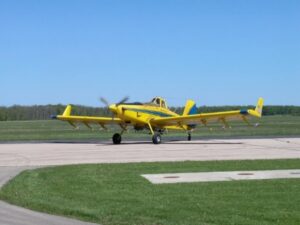By Bill McNee, Forest Health Specialist, Oshkosh, Bill.Mcnee@wisconsin.gov or 920-360-0942

Spray aircraft used in spongy moth control. Photo: Bill McNee
At a suitable time between early May and early June, an airplane will spray parts of four DNR properties to reduce the population of spongy moth caterpillars (formerly known as gypsy moth). Treatment dates will depend on weather conditions and caterpillar development.
This year’s high populations threaten to strip trees of their leaves and possibly kill high-value trees at these properties.
Aerial spraying will take place on a total of 625 acres at the following locations:
Big Foot Beach State Park (one site):
- Campground and forest surrounding the day-use area
Devil’s Lake State Park (two sites):
- North Shore day-use area and the Northern Lights/Quartzite campgrounds, plus a portion of the Ice Age campground
- South Shore day-use area
Governor Dodge State Park (two sites):
- Twin Valley campground
- The southern half of Cox Hollow campground
Kettle Moraine State Forest – Southern Unit (three sites):
- Horseriders campground
- Muir/Nordic trailheads
- Oak restoration area at the intersection of State Highway 67 and County Trunk Highway S
Detailed maps of the treatment areas can be seen on the DNR Forest Health website. Each site will be sprayed once; the spraying will take 10 to 30 minutes per site, depending on the size of the treatment area.
Spray information
- The plane flies very low and loudly over the treatment sites and surrounding areas. Spraying will only occur within the physical treatment boundaries.
- Planes may begin spraying as early as 5 a.m. and continue into the late morning or afternoon if weather conditions are favorable. Spraying could occur any day of the week.
- Law enforcement, local governments, schools, and medical facilities will be notified of the spraying beforehand.
- Sites will be sprayed with Foray, a bacterial insecticide that contains Bacillus thuringiensis kurstaki (Btk). Btk is a naturally occurring soil bacterium that kills only caterpillars when eaten. Btk is not toxic to people, bees, pets or other animals. However, some people with severe allergies may wish to remain indoors during nearby applications.
- The Foray product being applied is listed with the Organic Materials Review Institute as acceptable for certified organic food production.
- Upon visiting the Spongy Moth Information website, individuals can sign up for frequent email notifications of when the spraying will occur.
“Slow The Spread” treatments to begin in May
The Wisconsin Department of Agriculture, Trade and Consumer Protection will treat approximately 71,250 acres at 37 sites in 10 western counties as part of the national “Slow the Spread” program. This program treats low, leading-edge populations of spongy moth to slow the westward spread of the pest.
Slow the Spread treatments use either the same Foray insecticide as the DNR treatments or a pheromone mating disruptor that prevents moth reproduction by interfering with the ability of male moths to find female moths. More information can be found in this news release.
For more information about spongy moth and aerial spraying, visit the spongy moth information website, call the toll-free Spongy Moth Line at 1-800-642-MOTH (1-800-642-6684) to talk to staff, or hear a recording of up-to-date spray plans.
